https://www.moneycontrol.com/news/business/companies/garware-technical-fibres-could-transform-agriculture-and-fisheries-in-india-3028621.html
Garware Technical Fibres transforms India’s agriculture and fisheries
In some coastal areas, GTF has designed nets that actually allow the waves to bring in water and sand, but prevent the waters from carrying back the sand.
RN Bhaskar – Oct 10, 2018
Five years ago, hardly anyone would have bothered to take a second look at Garware Wall Ropes (which has now been rechristened to Garware Technical Fibres or GTF). Its shares were languishing, and the scope of its activities hardly known to many.
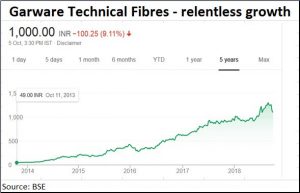 But since then, the markets have witnessed the steady but sharp climb of the company’s shares. Then take a look at its financials and a similar picture begins to emerge. Clearly, something unusual is happening with this company.
But since then, the markets have witnessed the steady but sharp climb of the company’s shares. Then take a look at its financials and a similar picture begins to emerge. Clearly, something unusual is happening with this company.
Talk to the company’s management, and the guys there will tell you (rather blithely) that they do not pay much heed to the stock market performance. But scratch a bit deeper, and you realise that this is a company that is determined to show to the market, that its animal sprits are raring to go.
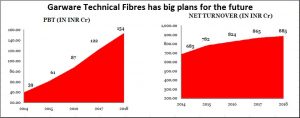 Probe a bit further and you will realise that, unlike most companies, GTF produces over 20,000 products (the company prefers to call them SKUs), which could be categorised into 13 verticals. Perhaps, no other company comes close to this range of products other than maybe the legendary 3M.
Probe a bit further and you will realise that, unlike most companies, GTF produces over 20,000 products (the company prefers to call them SKUs), which could be categorised into 13 verticals. Perhaps, no other company comes close to this range of products other than maybe the legendary 3M.
But there is a big difference. 3M focuses on products that can be mass produced. GTF focuses on products that are specially engineered. “They are designed and engineered to cater to the specific needs of the customer. To that extent, we are less market focussed as customer focussed,” says Vayu Garware, chairman and managing director, GTF. As company’s officials explain, “We must provide innovative, application focused solutions to enhance value of our customers globally
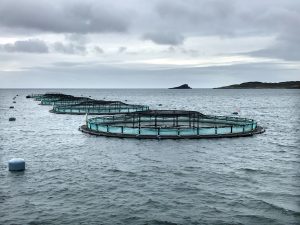 The primary focus of GTF, according to Garware, is on the food industry – particularly fishing, aquaculture and agriculture. The third is a recent addition to the company’s portfolio of products. “Some of the best and scientifically designed fishing nets come from our company. They are designed to meet specific objectives – to ensure that only the right type of fish is caught, leaving small fry to float away. We make nets that can carry huge tonnages. And each kind of fishing application has a different type of fibre and netting design. We design nets for fish farms too. Once again, depending on the fish that you wish to grow, we design a net for that purpose.” He explains how the nets are configured according to the type of fish that needs to be caught, the geographic terrain where the nets are to be used, and the tonnages involved. Hence a coastline which has rocks would require a different type of fishing net, that say a sandy beach. Likewise, the design of the net would vary on the size and type of fish that has to be caught.
The primary focus of GTF, according to Garware, is on the food industry – particularly fishing, aquaculture and agriculture. The third is a recent addition to the company’s portfolio of products. “Some of the best and scientifically designed fishing nets come from our company. They are designed to meet specific objectives – to ensure that only the right type of fish is caught, leaving small fry to float away. We make nets that can carry huge tonnages. And each kind of fishing application has a different type of fibre and netting design. We design nets for fish farms too. Once again, depending on the fish that you wish to grow, we design a net for that purpose.” He explains how the nets are configured according to the type of fish that needs to be caught, the geographic terrain where the nets are to be used, and the tonnages involved. Hence a coastline which has rocks would require a different type of fishing net, that say a sandy beach. Likewise, the design of the net would vary on the size and type of fish that has to be caught.
“We have to constantly educate fishermen on how to look at nets,” he adds. “Yes, we are a bit more expensive. But when fishermen realise how much money our nets save them, they opt for our nets.”
For instance, in India, a typical fishing trawler spends almost 80% of its expenses on diesel used to power the motors. By using the right nets, the trawler saves around 50-100 litres of diesel per trip. Typically each trip lasts around 10-15 days, and each trawler makes around 15 trips a year. Thus, by saving on diesel consumption, the trawler saves around Rs.4,000-8,000 per trip or over Rs. 1 lakh a year. Each fishing centre has anywhere between hundred to even thousands of trawlers. Just Veraval in Gujarat accounts for around 2,800 trawlers.
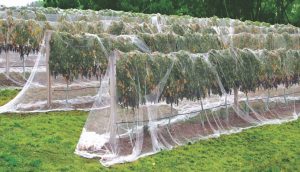 But how does that happen? GTF managers explain that while the power of the engines is focussed on the front of the vessel, the drag is in the centre and the fish is towards the end of the vessel. So a fishing net must be designed in such a way that the drag is reduced, without losing either the fish, or impacting the speed of the vessel. It must also catch the right type of fish. That requires a combination of the right material, the right configuration of the net and the right design. And that is where GTF wins.
But how does that happen? GTF managers explain that while the power of the engines is focussed on the front of the vessel, the drag is in the centre and the fish is towards the end of the vessel. So a fishing net must be designed in such a way that the drag is reduced, without losing either the fish, or impacting the speed of the vessel. It must also catch the right type of fish. That requires a combination of the right material, the right configuration of the net and the right design. And that is where GTF wins.
“We work with global research firms because we cater to a variety of fishing needs. In India fishermen use at best 250 HP boats. Overseas, they use vessels that use upto 10,000 HP. In India the catch size is generally around 70-80 kg. Overseas it can be around 1.500-2,000 tonnes,” explains Garware Then when it comes to aqua farms (see pix) the nets could as as wide as 180 metres with a depth of 30 metres. Many of these nets must be designed to keep the fish safe inside, yet preventing larger predators like sea lions from tearing the nets and devouring the fish inside. The nets need tensility, and yet must be light enough to ensure that the trawlers do not have the problem of a drag. GTF caters to those markets as well.
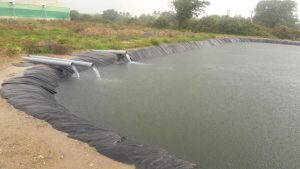 But Garware expects the biggest growth to come from agriculture in India. He has begun designing all types of nets for this sector – from poly-tents to bird nets with designs to keep away insects, survive hail and sun, and enjoy a long life-span too. His two big challenges are (a) educating farmers, and (b) persuading state government to shorten the subsidy repayment cycle to farmers. Unlike drip irrigation companies which offer to collect the subsidy for the farmer, GTF prefers to design the solution, sell the product to the farmer, but does not want to get into the activity of trying to get reimbursement of subsidies for the farmers.
But Garware expects the biggest growth to come from agriculture in India. He has begun designing all types of nets for this sector – from poly-tents to bird nets with designs to keep away insects, survive hail and sun, and enjoy a long life-span too. His two big challenges are (a) educating farmers, and (b) persuading state government to shorten the subsidy repayment cycle to farmers. Unlike drip irrigation companies which offer to collect the subsidy for the farmer, GTF prefers to design the solution, sell the product to the farmer, but does not want to get into the activity of trying to get reimbursement of subsidies for the farmers.
Related to agriculture is GTF’s focus on creating nets that prevent erosion of land in lakes, road embankments and even sea shores.
In some coastal areas, GTF has designed nets that actually allow the waves to bring in water and sand, but prevent the waters from 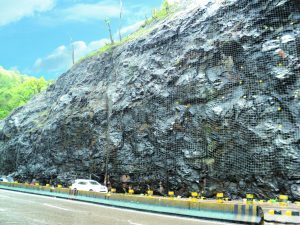 carrying back the sand. Thus erosion is prevented, and in the few years, land is also reclaimed from the sea. On highways and canals, it designs solutions that prevent land erosion, and keep canal water flowing along specified channels and ensure that roads are not washed away. The nets thus save colossal amounts of collateral investments from being washed away.
carrying back the sand. Thus erosion is prevented, and in the few years, land is also reclaimed from the sea. On highways and canals, it designs solutions that prevent land erosion, and keep canal water flowing along specified channels and ensure that roads are not washed away. The nets thus save colossal amounts of collateral investments from being washed away.
Using similar technologies GTF works very closely with governments. It designs solutions to prevent rock erosion near tunnel-ways and highways.
“That is why we prefer to see ourselves as a textile unit – with weaving and yarn making capabilities. Our raw materials are different, our markets are different as well, but the underlying technologies and the principles are the same,” adds Garware.
To buttress his view, he points to how his defence applications division creates fabrics that protect radar installations from sun, sand and hail-stones, without affecting the transmission of the frequencies used in detecting objects they are been designed for. GTF managers say that their products have reduced the purchase bill for defence units by almost two-thirds. Wherever specialised skills are required, GTF partners with the appropriate technology partner – with an Israeli company for the radar protection covers.
Today, GTF makes tents for the defence sector, and ropes that are lighter than steel but over ten times stronger than steel. Such ropes are used by the shipping industry as well. It makes nets for sports – Wimbledon tennis courts, baseball, badminton and squash courts.
Today, GTF is no longer a domestic company. It operates in over 65 countries, with its own office in six. In some countries like Canada and Scotland, it enjoys a high market share. In other countries like Chile it is just about to make its presence felt.
Given a global footprint and catering to sectors like food which are growing at an impressive pace, GTF does have its work cut out. It could be a company to watch very closely in the coming years.





























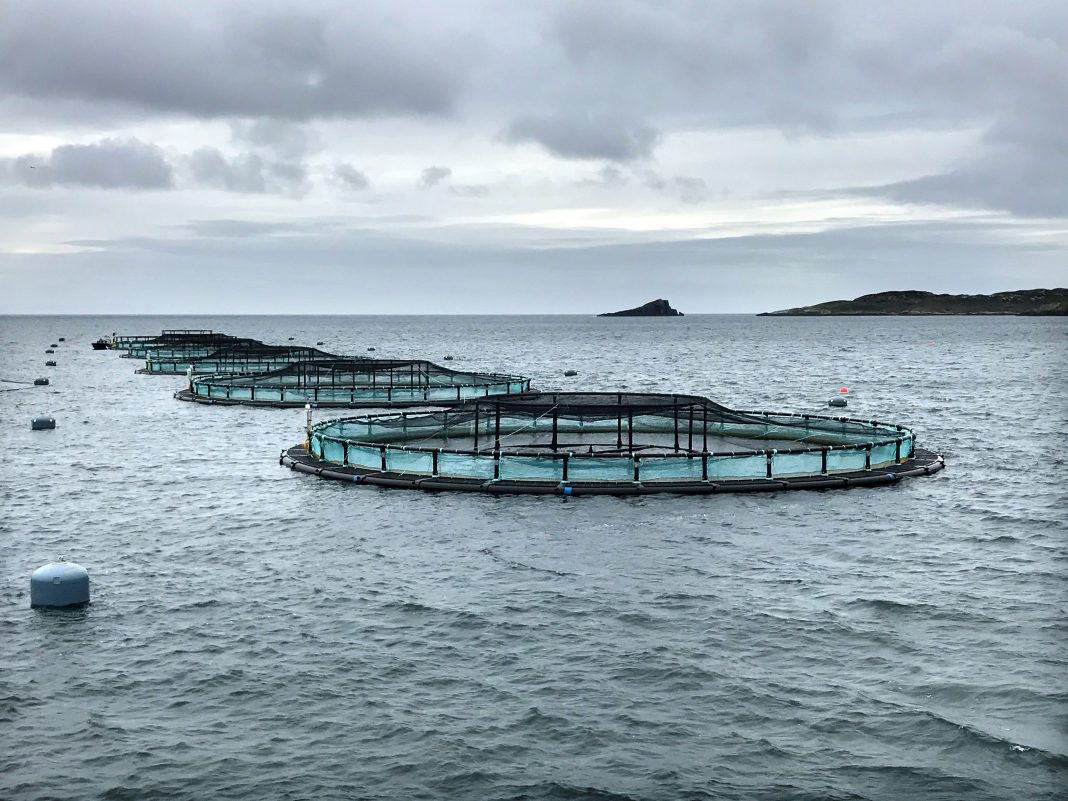












COMMENTS